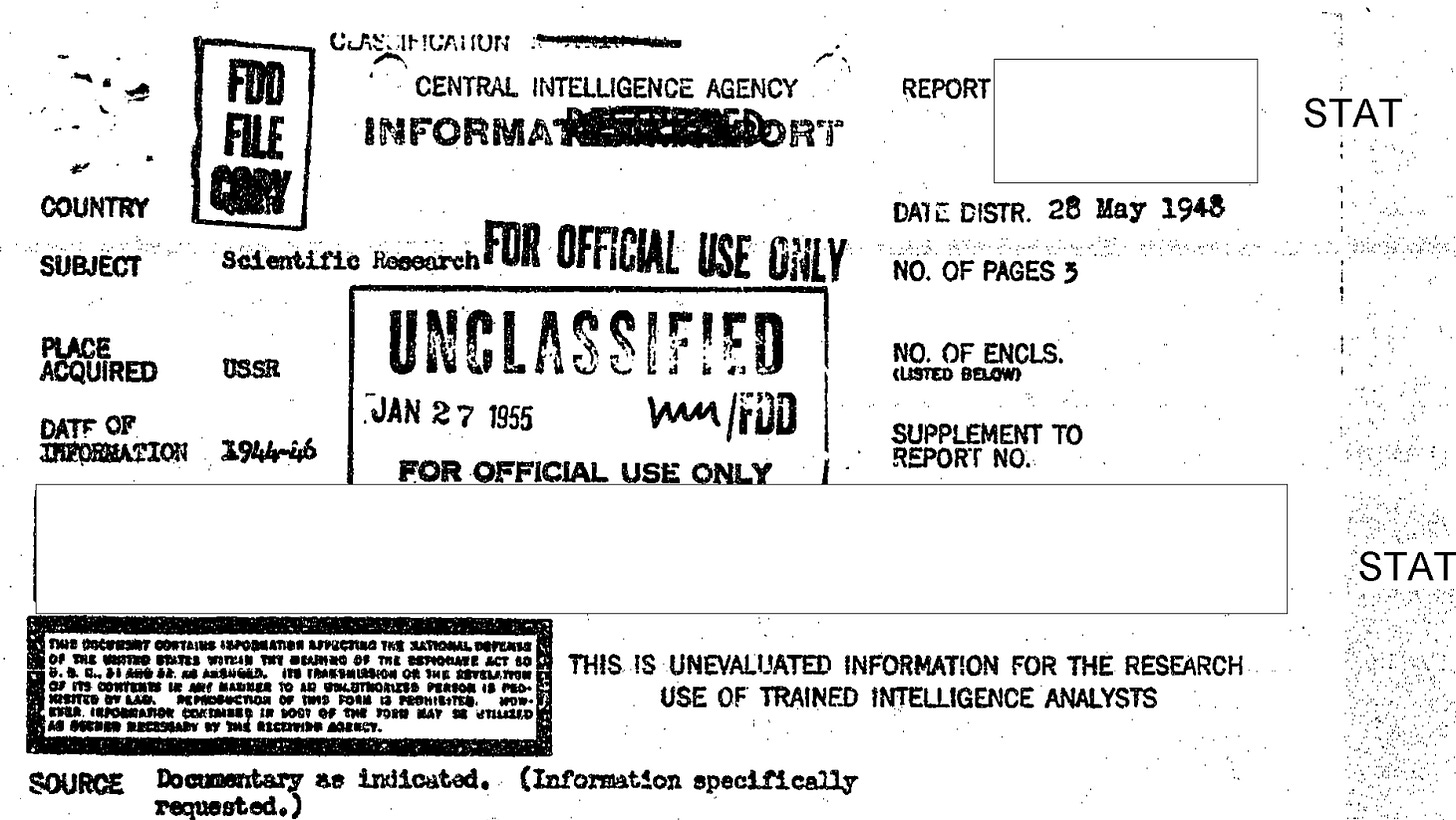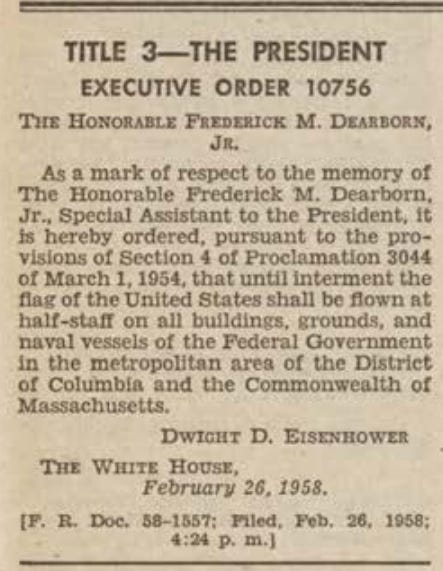I recently spoke with someone who knew Fred Dearborn well.
Dearborn was a White House official whose sudden death in the early morning hours of February 26, 1958 left an opening on President Eisenhower’s staff that Jay’s cousin, Karl Harr, would fill.
I have long found Dearborn’s death suspicious, and it turns out I was not the only one.
When I told the source that L. Fletcher Prouty, the Air Force’s liaison to the CIA from 1955 to 1962, had observed a change in the board when Karl replaced Dearborn - a move by the CIA toward more audacious covert operations - my source said something that made me almost fall out of my chair.
“Here is a question you may think is weird,” my source said. “How did [Fred Dearborn] die?”
My source, who had played touch football with Dearborn just weeks before his passing, said that while Dearborn was not an athlete, he “was fully physically capable” and was by all indications in good health.
“There is no evidence that he could be ready to die,” my source told me.
It seems questions around Dearborn’s death were on both of our minds, and perhaps the desire to find answers, even at this late date, is the main reason why my source agreed to speak with me.
Clarifications and a lead
My source, who knew Dearborn well, confirmed the main facts as presented in my most recent article on this topic.
The source confirmed my suspicion that Dearborn was, in fact, good friends with Undersecretary of State, and former Governor of Massachusetts, Christian Herter. Further, it was Herter who pressed Eisenhower to find Dearborn a role in Washington that would enable the two men to continue their fruitful political partnership.
In response to my question seeking clarity on Dearborn’s cause of death, two of which were listed in various newspapers, my source had heard only about acute inflammation of the pancreas.
My source did not know the name of the maid who discovered Dearborn’s body and is not in possession of Dearborn’s death certificate.
However, this person did relate a crucial clue.
“My recollection is that somebody immediately had the house roped off and it was inaccessible to anybody,” my source said.
This person made it clear that it was federal authorities who were detached to the home that morning, not D.C. police.
Remnants of MKNAOMI
The possibility that Fred Dearborn, a man whose job involved coordinating covert operations, may have been murdered sent me in search of specifics about the CIA’s methods of assassination in the 1950s.
I needed to know if anything the Agency was working on could be plausible in the Dearborn case.
A 1975 summary report on the CIA’s investigation of project MKNAOMI provides very important information about the CIA’s research into lethal toxins during this time period (emphasis added).
The CIA relationship with SOD [the Special Operations Division] was formally established in May 1952 through a memorandum of agreement with the Army Chief Chemical Officer for the performance of certain research and development in the laboratory facilities of the Special Operations Division of the Army Biological Laboratory at Fort Detrick. The animus for establishing this relationship seems to have been a belief in OTS [Office of Technical Service] that the special capabilities of the Fort Detrick group and its access to biological materials of all sorts provided the Agency with expertise and capabilities which were appropriate to its function and not otherwise available. Discussions indicate that the perception of the requirement for such capabilities was tied to earlier OSS experience. Initial funding was at the $200,000 a year level which grew to a high point in FY 1958 of $390,000 [about $4.2 million today] and then dwindled to $75,000 a year in the late 1960's.
FY 1958 spanned from October 1, 1957 through September 30, 1958, meaning that Fred Dearborn died at essentially the midpoint of the fiscal year in which funding for the CIA’s biological warfare research at Ft. Detrick was at its highest.
The report detailed the research start and end dates, as well as the applications for the toxins under investigation (emphasis added).
These applications clearly included one-on-one situations in which clandestine delivery was a concern. Both standard BW [biological warfare] agents and biologically derived toxins were investigated by the Division. Discussions with former Fort Detrick employees indicate that SOD was first established as a distinct, highly secure activity within Fort Detrick in about 1948, though no records going back that far have been found. The Division was abolished in 1970 or 1971 as the Fort Detrick operation was terminated.1
The CIA is, by definition, a secret arm of the government, but this project was among the most tightly guarded secrets within the Agency in the mid-twentieth century.
Most importantly, everyone was careful to keep their fingerprints off this deadly work (emphasis added).
From its outset the project was characterized by a compartmentation that was extreme even by CIA standards. Only two or three Agency officers at any given time were cleared for access to Fort Detrick activities. This work was managed first within the Biology Branch and later in the Chemistry Branch of TSD (Technical Services Division). Because of the sensitivity of the activity, queries by operations officers as to the availability of materials and delivery systems of the type being developed at Fort Detrick were automatically turned away by TSD unless initial approval for contact had been given by the Deputy Director for Plans [Frank Wisner held this position in early 1958, but his mental state was fragile. Following a severe nervous breakdown in September of that year, Wisner was supplanted by Richard Bissell]. Even when this was the case, the Chief of TSD often referred the operations officer directly to one of the cleared officers dealing with Fort Detrick and was never informed as to the nature of the discussions. This method of procedure has been confirmed both through interviews and by the IG report on assassination planning. No written records were kept. Though some CIA-originated documents have been found in the project files, it is clear that only a very limited documentation of activities took place. No records on such things as material control, receipt, delivery, destruction, etc. can be found. No documents relating to any possible operational use of the material have been found.2
The report mentions the CIA’s infamous dart gun and notes that lethality was easier to achieve than incapacitation.
One development peculiarly associated with the CIA was the "microbioinoculator”, which was an extremely small dart device which could be fired through clothing to penetrate the skin so as to inoculate him with an agent of some sort without the target's perception of being hit. An added fillip to this development was the requirement that no indications of the use of such a device be discernable in the course of autopsy.3
The existence of the dart gun, a key nugget in the report, was broadcast nationwide at the beginning of the Church Committee hearings in 1975.
Note that in the video, William Colby, then the Director of Central Intelligence, admits the following under oath:
The dart gun was used for offensive means (to murder people)
Darts were created from an array of different toxins
Some darts were able to evade detection by the victim and during an autopsy
Venom
The report is vague about some of the more exotic toxins found at Ft. Detrick:
The shellfish toxin -- along with 8 milligrams of cobra venom -- was found by David Boston, currently Chief of the Chemistry Branch, in Vault B10 in the basement of South Building which houses OTS. This vault is a lightly used laboratory area and historically associated with the Biology and Chemistry Branches of OTS…The shellfish toxin was…put into the freezer in February 1970, and the cobra venom, in February 1961….After finding the shellfish toxin in the vault, a complete inventory was taken. A large number of dangerous chemicals or drugs of various types were found. These materials relate to a number of past programs of TSD, including the drug project, the development of harassment materials for crowd control or meeting disruption, crop contamination programs, etc. Small amounts of several other lethal preparations were found. Two of these are known to have been obtained by the Agency for testing at Fort Detrick. Nothing is known about three others.4
If SOD was testing cobra venom on behalf of the Agency, what other types of venom might fall under one of the vaguely worded groupings outlined above?
We know that the Agency’s interest in venom as a bio-warfare weapon dated to the 1940s.
A summary of Soviet scientific journal articles declassified in 1955 reveals the CIA’s interest in both scorpion and spider venom.
Scorpion venom produces an inflammatory response from the human body, the results of which can lead to both cardiac and pancreatic injuries (emphasis added):
Experimental studies have shown that the injection of whole venom and purified toxins from the venom of scorpions can cause profuse salivation, increased gastric and pancreatic injuries as well as disorders of intestinal motility [113–117]. Most of these effects have been related to the acute autonomic disturbances triggered by the venom, which can provoke both the activation and delayed inactivation of neuronal sodium channels, where they modulate the release of neurotransmitters, that leads to a variety of adverse effects which include respiratory failure, lung edema, arrythmias, tachycardia followed by bradycardia, skeletal muscle stimulation, lacrimation, convulsions, and enlarged pupils, among others [112, 116–124].
This finding raises an interesting question. What if Fred Dearborn suffered both acute pancreatitis and some sort of cardiac event in his final moments? It is possible that both strands of news reporting on his cause of death are correct.
Last words
The first mention of Fred Dearborn’s death from the government came when President Eisenhower issued Executive Order 10756, mandating that flags on all federal buildings in Massachusetts (Dearborn’s home state) and the District of Columbia be flown at half-staff.
The executive order was filed at 4:24 p.m. on February 26.
Eisenhower held a press conference that morning. Notes in the Eisenhower Presidential Library identify the following main lines of questioning:
Bulganin; IRBM bases in Britain; Tunisia; Pineau talk; UAR, Russian Ambassador; Benson; economy; FCC and Mr. Mack; S. Adams; Arthur Burns letter re economy; mutual security; Dr. Killian on space program; presidential disability; Axel Beck appointment; questions and answers on “White House clique,” cost of living
The full transcript reveals no mention of Fred Dearborn.
There was also an Operations Coordinating Board luncheon that day. As the Board’s vice chairman, Dearborn attended all of its meetings.
Allen Dulles’s memorandum for the record, filed the next day and declassified in 2003, does not mention Dearborn.
From the documentary record, therefore, it is likely that official word of Dearborn’s death reached the executive branch around mid-afternoon.
Of course, none of this proves that Fred Dearborn was murdered, by venom or any other means.
But I didn’t set out to prove anything today.
Rather, I was trying to disprove the plausibility of the CIA having a hand in Dearborn’s death.
I failed in that endeavor.
There are more strings to pull here.
Ibid. Pg. 9.
Ibid. Pg. 11.
Ibid. Pg. 15.





